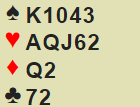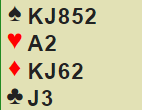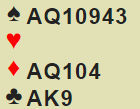AuthorOpener's rebids #1 - new suit at the 2-levelYou opened 1 of a Major, and your partner responded with a new suit at the 2-level. The auction is forcing to game (or at least to a rebid by responder, if you prefer the style that allows for the one-suited invitational exception. More on that in the next article). This means that there is no need to jump with strength. Jumps are therefore defined to show specific hands. The general principle governing the entire structure is that hands without a clear direction bid slowly. This means two things:
So, after 1 Spade - 2 Clubs, you should bid 2 Diamonds with both of these hands: If you are thinking that you may never catch up if you bid only 2 Diamonds with the 2nd hand, all I can say is that your instincts are in the right place! You should be yearning to show your enormous playing strength (particularly after partner shows a nice hand with 2 Clubs). But the hand is too complicated for you to jump around. You can end up playing a contract in spades, diamonds, or clubs (or perhaps notrump if partner insists on it after you show your diamonds, i.e., if he has good heart stoppers); and you can stop in game only (which is admittedly very unlikely), or in a slam, or in a grand slam. To explore all of these possibilities properly, you should take advantage of the entire bidding space available. Note that you will have to take control of the auction later. Partner will never play you for a hand this strong. One of the most common pitfalls of 2/1 bidding is that a player believes that, because the auction is forced to game, he should just go through the motions (of suit establishment and cuebidding) and then the final contract will be reached almost automatically. That is not correct. When the hand is in the slam zone, one or both players must take the plunge and go beyond the game-level. The second hand above is far too strong to not invite slam (very strongly). (Actually I think I overshot when imagining that hand. I can't really picture myself stopping short of slam once partner shows clubs and a game-forcing hand). The most difficult hands for the 2/1 style are the in-between hands. When you have, say, one less King than hand 2 above, you often have to take a chance at the 5-level to explore slam possibilities. But that's a subject for future articles. For now, the point is that a non-jump rebid in a new suit is unlimited in strength. It is also unlimited in distribution. 2 Diamonds shows at least 5-4 in spades and diamonds, but it can go all the way to a 7-6 hand (you won't see those very often). More realistically, it can be bid with 6-4, 5-5, 6-5, and often with 7-4 (although in this last case rebidding spades will also be attractive in many situations). So far all I've been discussing here is "standard and best". There is one case of the non-jump rebid in a new suit at the 2-level which has no "standard" interpretation, and which must therefore be discussed with your partner. I mean, of course, the 2 Spades rebid by a 1 Heart opener: the auction 1 Heart - 2 of a minor - 2 Spades. There are two main schools in play here. Either this shows extra values (roughly 14+; a hand which will accept a one-suited game invitation if that is allowed in your structure), or it may be bid with any minimum. The core of the problem is how to bid a minimum 4-5 hand:  I have seen hands like this result in lost imps at a very high level, due to a lack of discussion between partners as to how to deal with them. Should this hand bid 2 Spades after 1 Heart - 2 Clubs, or should it be content to bid 2 Hearts? Let us look at the pros and cons of each approach. Style #1 - 2 Spades is a reverse (showing extra values)Pro: gives more definition to a 2 Spade rebid, which may come in handy if responder is interested in slam. Con: Makes it necessary for responder to bid 2 Spades over 2 Hearts whenever he has 4 cards there, else the fit will be lost. 2 Spades may not be the most natural bid (imagine something like Q9xx x AJ9 KQJxx -- he would like to show a strong preference for NT now, rather than suggest a spade contract), but this is the trap that must be avoided if you are playing this style. Someone has to bid spades when that is the best strain! Style #2 - 2 Spades is not a reverse (may be bid with a minimum)Pro: releases responder to bid more naturally with 54 in the blacks (or even 44 in the blacks, which should often start with 2 Clubs with game forcing values -- a subject for a later article).
Con: may make it harder for responder to sort out opener's strength, when he is interested in high contracts. I prefer to build the system so as to make it easier for us to reach the best game. Choice of games is more often important than slam bidding. (Though it must be noted that slam bidding is a very close second issue in that hierarchy). So, my recommendation is that you should play Style #2. But whatever is your choice, discuss it with your partner! Both of you must be in the same page here, and without clear discussion of this issue, there will be bad results, guaranteed. Style #2 will be assumed when we discuss responder's 2nd bid. In the next article, other non-jump rebids by opener: the rebid of the major suit, the raise of partner's suit, and 2NT.
1 Comment
|
Archives
September 2021
Categories
All
|


 RSS Feed
RSS Feed